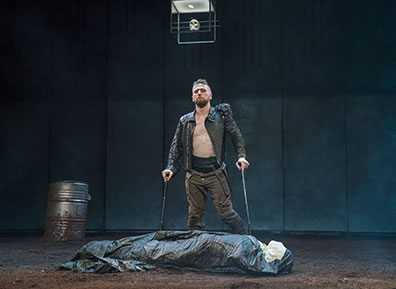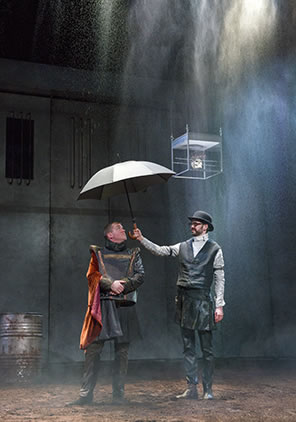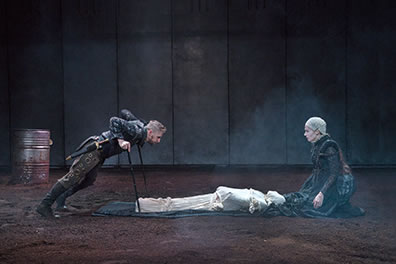Richard III
Crowning Chutzpah with Crutches
A Review and Interview
DruidShakespeare, Gerald W. Lynch Theater at John Jay College, New York, New York
Sunday, November 17, 2019, K–101&102 (Right center, near back)
Directed by Garry Hynes
The stage, hemmed in on three sides by blackish metallic walls, is bare except for a steel barrel at the back and a shovel off to the side. A skull inside a glass box hangs from the center ceiling. A woman wearing a white shroud, bent under the wearying weight of a tragic life but fiercely determined to not yet die, shuffles across the stage. This ghostly figure finishes her passage, and the theater lights go out. When the stage lights come back up, a grave has opened up near the front of the dirt-covered floor. We wait.
Richard pops out of the grave like a delighted Dick-in-the-box.

Richard (Aaron Monaghan) stands over the shrouded body of Henry VI, wrapped in the train of Lady Anne's dress, in the DruidShakespeare production of William Shakespeare's Richard III. The production is part of the Lincoln Center White Lights Festival. Photo by Richard Termine, Lincoln Center.
“There’s a different Richard every night,” says Aaron Monaghan, who plays the title character in DruidShakespeare’s production of William Shakespeare’s Richard III at John Jay College’s Gerald W. Lynch Theater, part of the Lincoln Center’s White Light Festival. In an exclusive interview after the performance, Monaghan describes the “many aspects” to a role he was destined to play from the time he as a channel-surfing lad happened upon an iconic performance of Richard. With a glorious command of Shakespeare’s verse that he sometimes plays like a jazz musician’s approach to a Mozart score, Monaghan presents a Richard living in the moment: his moment, the character's moment, and the real Richard III's moment. “Literally, when I pop my head up, I don’t really know what way it’s going to come out.”
For this Sunday matinee performance, it initially comes out as a cynical sing-song passage through the first 13 lines of Richard’s opening soliloquy, “Now is the winter of our discontent…” He comments on a nation at peace and at play with a snideness that lands hard on his disdainful description of his brother, King Edward, capering “To the lascivious pleasing of a lute!” Then, the full Richard emerges: vocally, as he turns bitter in addressing his deformity, and visually. He plants two sticks on the stage to lift himself out of the grave, and the sticks serve as his crutches throughout the play.
This is the Galway, Ireland-based company’s third participation in the White Light Festival, having brought its epic cycle of Shakespeare’s second history tetralogy here in 2016 and Samuel Beckett’s Waiting for Godot last year. Director Garry Hynes, Druid cofounder and artistic director, and much of Druid’s regular ensemble of actors (13 in the cast of this production) are the common threads through all three productions, and those threads leave behind familiar strands, such as Monaghan standing in a grave. In the history cycle, Monaghan memorably played a number of characters, including a gait-disabled Pistol, with one foot stuck straight out and unable to bend his knee, probably from a self-inflicted gun wound. His Exton in Richard II ended up digging the king’s grave during the intermission between that play and Henry IV, Part One. In the intermission between Henry IV, Part Two and Henry V, Monaghan raked up the dirt on stage before literally jumping into the role of Chorus. “Garry and the team are very good at going back and looking for motifs and themes and things like that,” Monaghan says. “And that kind of translates into the ensemble and style. We thought it would be something interesting with me coming out of the grave,” not to mention speaking one of Shakespeare's most famous lines upon doing so, as he did with Chorus.
A more bizarre thread is the bowler hat Catesby (Marty Rae) wears and the umbrella he employs in a production otherwise dressed in Elizabethan costuming (Francis O’Connor designed the set and costumes). Those props and Rae’s brogue-droll reading of the steady, devoted civil servant recalls his Vladimir in Waiting for Godot. His use of an electric captive bolt stunner to execute Richard’s victims recalls the steady deadly attitude of Javier Bardem’s Anton Chigurth in No Country for Old Men.

Catesby (Marty Rea) holds an umbrella for a curious but nonplussed Hastings (Garrett Lombard) in the DruidShakespeare production of William Shakespeare's Richard III. The production is part of the Lincoln Center White Light Festival. Photo by Richard Termine, Lincoln Center.
In Druid’s history cycle, Hynes and adaptor Mark O’Rowe rode an allegorical arc that explored how the goals and perspectives of the royal “we” diverge from those of “we the people” they are supposed to represent. Over the course of four plays through three kings, we see how the monarchy, despite different styles and personalities, never really changes; nor does the public’s suffering under their ambitions. In skipping over the Henry VI trilogy to Richard III, the final chapter of Shakespeare’s War of the Roses cycle, Hynes continues to explore such timeless political realities and personalities, with one personality dominating them all: Richard.
“What I find really fascinating about this play is that we’re cheering him on because it’s entertainment until he’s not entertainment anymore,” Monaghan says. “That’s what I feel the challenge is. I feel there’s a further challenge in that if you can charm the audience, if you can get them on your side, you can entertain them to want even more, and then around Act Four to feel I backed the wrong horse here. That’s a great challenge. The further challenge I feel as an actor is thereafter to maybe make them feel sorry for him and to maybe make them feel that he has some sort of human character. And that’s that last speech.”
He means the Act V soliloquy after Richard awakes from the dream of the ghosts of his victims visiting him (here reduced to just the two murdered princes singing their warning). I measure the overall efficacy of Richard performances by how they handle that last soliloquy in which Richard has moved from directly addressing the audience to directly addressing himself. Monaghan plays this speech as a psyche divided, Richard trying to come to terms with the villain he’s become, so evil he’s finally frightened himself. The actor is also thinking of someone else. "There’s always a bit of subversion with Shakespeare. I always feel this. And I’ve been trying to figure out where the subversion is, and I think that’s it: he makes us like him." Even though the play abides by Tudor propaganda, he says, "He’s ensured that Richard III will never be forgotten, the real Richard III. Yes, he’s a bastardized version, and the real-life Richard is not even half as remotely interesting as Shakespeare makes him. I’m not all that interested in the real Richard III, I’m really not; I love Shakespeare’s version. But, nearly every night I get to that last speech again, and when I get to the line where I say, “There is no creature loves me, and if I die, no soul shall pity me,” I very, very much think of the real-life Richard III who was underneath a car park until very recently. I feel Shakespeare is being subversive; he’s saying, this was a real guy who ended up strewn across a horse with more wounds inflicted after that."
In my experience, the best Richards in this moment—who consequently keep the audience’s attention riveted on him after a long, exhausting play—are those who have played the character in the cycle’s previous two chapters, Henry VI, Parts Two and Three. Monaghan hasn’t done that (he hopes Druid some day fits the Henry VI plays into its repertoire and stages the entire cycle), but he tells me he studied those plays as part of his preparation.
Up to that last speech, though, Monaghan is a laugh-track generating bolt of constant energy, casually scheming his way to the throne with audacious duplicity. He shows off a blackened, cramped-tight hand (that wasn’t black minutes earlier) to accuse Hastings (Garrett Lombard) of abetting a witch. After ordering Hastings' beheading, Richard uses that supposedly crippled hand to catch the crutch Buckingham (Rory Nolan) tosses him. Afterward, Richard and Buckingham sit by Hastings' grave eating the bishop’s strawberries as they plot their next move while, in the grave unseen to the audience, Catesby saws off Hastings' head. When Richard finally becomes king, he tries to reach Edward's crown that had earlier been placed on the skull in the glass box, but Monaghan is too short. "Cousin of Buckingham!" he shouts. "Give me thy hand." Nolan strides to Richard, grabs him around the waist and lifts him "Thus high" to the crown, a great visual pun Shakespeare no doubt would love.
One cannot watch Richard III today without thinking about President Donald Trump or, on the other side of the Atlantic, Boris Johnson. It's not just the main character’s mendacity and despotic tendencies. It's also his use of such mechanisms as concocting conspiracy theories (Edward as a bastard) to bolster his own power, or bathing his blatantly nonpious self in a righteous light to win over the conservative Londoners. Trumpism and Brexit were on the minds of the Druids as they built their production (Monaghan even refers to the blackened hand scene as “fake news”), but they resisted making any obvious visual references. “I think to push some things so literal on such a great play is death,” Monaghan says. “That’s not to say it’s not there, but if you push something on a play and tell the audience what to think, I think you rob them of the act of imagination.”
Nevertheless, Hynes makes one stunning connection between Richard III and the political drama currently playing out on our televisions: she leaves in the Scrivener scene and uses Catesby to play the role. In this 14-line scene that too many productions cut, the Scrivener tells the audience how the timing of the document for Hastings' indictment doesn’t correspond with the timing of his quick death. “Why, who's so gross that seeth not this palpable device?” Catesby says looking at the indictment. Then Rea motions to the audience: “Yet who's so blind, but says he sees it not?” This leaves a wake of self-reflecting utterances across the auditorium as the lights go out signalling intermission.
Monaghan’s portrayal of Richard is not Trump, but it does spur a specific visual recall for experienced Shakespeareans: Antony Sher using crutches when he played Richard in the 1985 Royal Shakespeare Company production, which I saw in London. “To be honest, I kind of wanted to stay away from [the sticks],” Monaghan says. But in the first week of rehearsal, Hynes and Movement and Fight Choreographer David Bolger began visualizing how Richard would look and move. “They brought in these sticks. I was very aware that you’re never going to be able to get away from the ghost of Antony Sher. But they liked it, so I just went, OK, I’ll stick with them.” The irony is that, as a boy, Monaghan happened upon a TV documentary about the Sher production. He had no idea what it was about, but “I watched the entire thing just out of curiosity.” In college, his voice coach gave him Richard’s last soliloquy to work on, and Monaghan soon pieced together the speech with the documentary he had seen eight years previous. “I kind of became obsessed with this character.”
Monaghan does not emulate Sher beyond the presence of crutches. Sher’s was a deeply psychological reading drawn from extensive research into various pathologies but lacking any basis in the Henry VI Richard. For his Richard, Monaghan does draw on Shakespeare’s backstory as well as the omnipresent cultural influences of reality TV show divas. The two actors even differ in their movements with the crutches. Sher, using black crutches and wearing a black coat with tails, portrayed the “bottled spider.” Monaghan is more the “bunchback toad” and resembles a Komodo dragon as he creeps up on Lady Anne during her eulogy over King Henry VI’s body. Monaghan tells me he also incorporated the movements of a gorilla in the way he gets to his feet, using the crutches as elongated arms to lift himself like a silverback pushing up on his knuckles.
Moreover, the crutches were no more than a device in that RSC production: Hynes incorporates them into her production’s overarching imagery, employing them as a thematic visual clue after the climactic Battle of Bosworth fight between Richard and Richmond (Frank Blake). Bolger’s choreography is effective not in the acrobatics of the swordplay but in how the two combatants stumble after and over each other, a combat of increasing exhaustion. Richmond finally commandeers Richard’s sword and uses the two blades to slice and dice the king, who falls into the grave—of course, where, on this day, the actor ponders the real Richard's burial under a car park. Richmond collapses to the stage and, sitting with the two swords, gasps out his final speech on unity and peace. Then, he relies on the swords to lift his exhausted body and staggers off the stage with the swords as his crutches. The succession of monarchy remains unbroken.
Despite the comic energy reverberating through the action, the production, clocking in at three hours including a 15-minute intermission, maintains a tragic undertow yielding many haunting images. Lady Anne (Siobhán Cullen) drags Henry’s mummified body on the train of her dress. Monaghan and Cullen pull off a high-voltage, high-wire act in the scene as Monaghan step-by-step builds up to Richard’s successful wooing of the woman. Anne, all-in on the kneeling Richard’s offer to kill him with his dagger, is in midthrust when he shouts, “Nay, do not pause!” startling her into doing just that, pausing with the dagger poised above her head. Richard’s acute timing on the millisecond gives him the edge he needs, and her pause becomes permanent. Offering her his ring changes her demeanor, whether it’s the token’s material richness or the power it wields that entices her. “To take is not to give,” she says defensively as she covetously stares at the ring, and after he slips it on her finger she admires it there before departing. Richard disengages Anne’s train from her dress and uses it to fully encase Henry’s body while expressing his desire to give it proper burial. After she leaves, he drags the body across the stage and kicks it into the grave.

Richard (Aaron Monaghan, left) accosts Lady Anne (Siobhán Cullen) over the body of Henry VI in the DruidShakespeare production of William Shakespeare's Richard III, playing as part of the Lincoln Center White Light Festival. Photo by Richard Termine, Lincoln Center.
And after he leaves, the old woman in white approaches the grave, scatters dirt in, and then huddles in a corner to eavesdrop on the court. This is Henry’s widow, Queen Margaret, whom Marie Mullen imbues with the inner strength and arrogance of the character that dominates the Henry cycle. She’s deeply bitter, but in her weary way she bears a triumphant spirit as she watches the self-disintegration of the House of York. She doesn’t win; but neither do they. Mullen's performance exemplifies this fine ensemble's talent at producing memorable multidimensional characters residing in the title character’s distorted shadow. Nolan’s Buckingham is the cautious politician who gets swept up in Richard’s power grab. Lombard’s Hastings is the privileged politician, smoothly spinning a web around his enemies while oblivious to the praying mantis looming over him. Lombard also plays Tyrrel, who murders the young princes in the Tower. He describes the deed in a passage he delivers with disturbingly poetic beauty.
Where these actors most shine, though, is in death. I’ve never seen better played corpses, collapsing to the ground, even midverse, the instant Catesby fires his stunner into their heads. It misfires twice during Buckingham’s execution, and as he turns in his chair looking at Rae's Catesby in exasperation, third time’s the charm; Nolan's flies backward, his legs sprawled over the capsized chair. When it comes to playing dead, though, nothing compares to Rea's Tony-worthy portrayal as the corpse of Clarence. Rea is marvelous as the clueless and guilt-ridden brother of King Edward and Richard, and it’s a shame his remonstrance to the murderers is among the excisions in Hynes’ otherwise good cut of the script. The suddenness and intensity of his murder makes up for the lost passage as he’s stabbed and violently drowned in the steel barrel. That violence melds into comedy as the First Murderer (Blake) flings Clarence’s lifeless body around while arguing with the Second Murderer (John Olohan) before dropping Rea in the grave.
Whereupon Richard scrambles onto the stage, kicks dirt into the grave of his now-dead brother, and moves on to his next target.
“You’re always feeling as an actor, you’re never going to be able to emote better than Shakespeare has written it. You just aren’t,” Monaghan says. “He’s given you all the punctuation, all the right consonants, and all the right vowels in all the right places. As an actor, you’re continually discovering that all you’re ever doing is yielding. You can’t start that [opening] speech and put this curtain of character up between you and the audience. You’ve got to go,” and Monaghan spreads out his hands in a gesture of release. “It’s a very difficult and brave thing to do, but, my god, it’s satisfying.”
Eric Minton
November 23, 2019
For the complete interview with Aaron Monaghan, click here.
Comment: e-mail [email protected]
Start a discussion in the Bardroom



 Find additional Shakespeareances
Find additional Shakespeareances